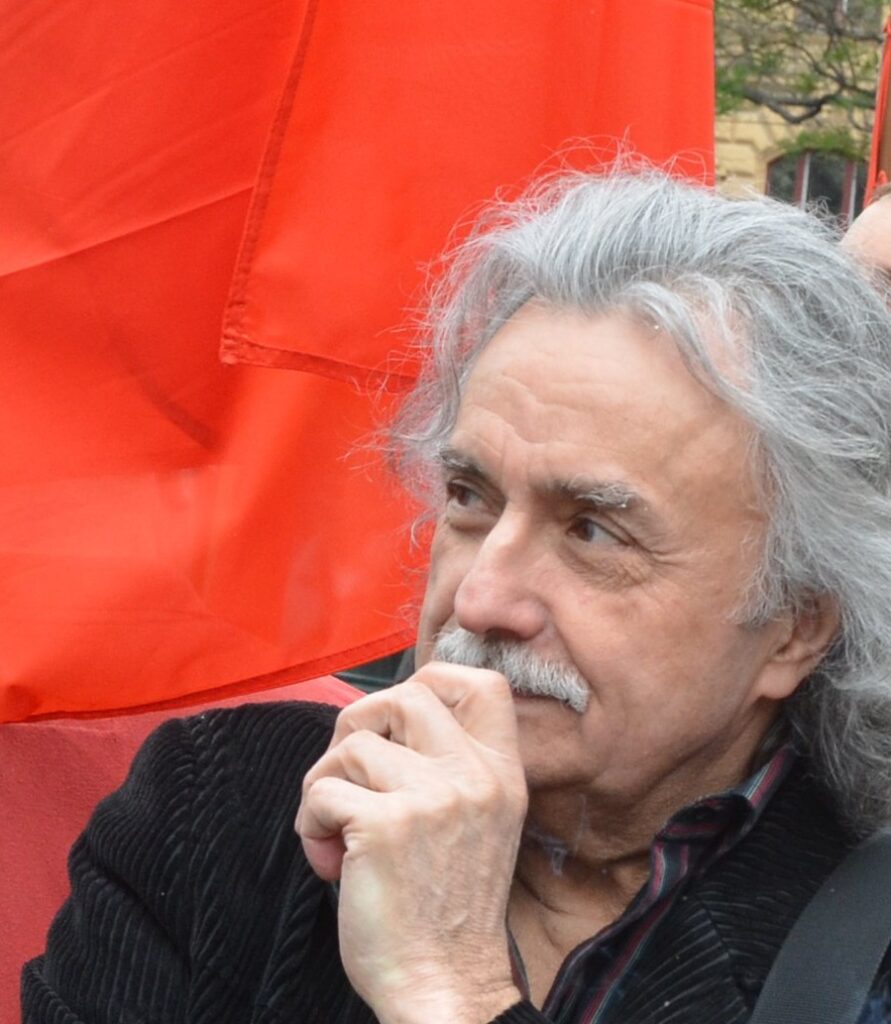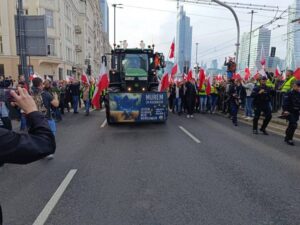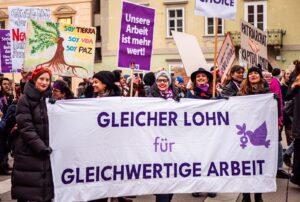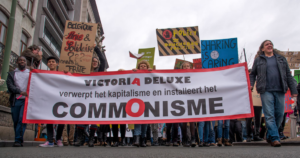The ¡No pasarán! – Contested Memories symposium examined politics of remembrance, revisionism and anti-fascist resistance in the Alps-Adriatic Region. transform! europe’s Michael Hollogschwandtner spoke to conference organiser Mirko Messner.
he ¡No pasarán! – Contested Memories symposium was held on 14 and 15 May 2022 at the VolXhaus/Ljudski dom event space in Klagenfurt/Celovec, Austria. The conference was organised by the Interregional Forum of the European Left (EL) in the Alps-Adriatic Region with the participation of transform! europe. In attendance were researchers, artists, politicians and civil society actors from the Friuli Venezia Giulia region of Italy, Croatia, Slovenia, and Carinthia/Koroška (Austria) whose work and activism focus on politics of remembrance.
Michael Hollogschwandtner: How did the idea of organising a symposium on this topic come about?
Mirko Messner: Those of us involved in the Interregional Forum of the Party of the European Left (EL) are driven by the same desire: to counter the hegemonic politics of remembrance in the Alps-Adriatic Region by offering a progressive alternative. This is an area where we share many similarities but also face numerous contradictions. Our pasts and our presents also differ, but everywhere the subject is essentially framed within the same context, i.e. European revisionism. We came up with the idea of learning about various strategies to confront this trend through international discussions. Our aim was also to analyse the weaknesses of left, anti-fascist and anti-Nazi politics of remembrance. Lastly, another key motive for us was to address the gap in knowledge that exists between those from a post-war generation such as mine, and younger generations. A politics of wilful forgetting is partly responsible for widening this gap in social amnesia – an amnesia that is no longer recognised as such.
 At its core, anti-fascist resistance was inextricably linked with the desire for the social transformation of society.
At its core, anti-fascist resistance was inextricably linked with the desire for the social transformation of society.Because there is a lack of knowledge about anti-fascist resistance?
Precisely. And about how Nazi fascism could take root and spread among the masses; how a mix of antagonisms related to class, politics, and culture could even give rise to such an ideology in the first place. Our education systems do nothing to help matters; in fact, they facilitate the politics of forgetting to varying degrees. Traditional anti-fascist organisations resist as best they can, but the way they present themselves often makes them look antiquated. In no way do I wish to disparage their work – it should be celebrated – but their activities are largely related to the past. They focus their attention on the victims of the Nazi regime and honour those involved in the resistance, but little consideration is given to living connections with the social struggles of the present. And in the public eye, anti-fascist resistance often takes a backseat, pushed into the background by the ideological state apparatus, shoehorned into the totalitarian discourse, and, at best, constrained to its national borders. But for those who were actively involved in anti-fascist resistance, the prospect of a democratic social transformation rooted in mutual solidarity was key. Take, for instance, the words of resistance fighter Lipej Kolenik: “Once we have defeated the Nazis, we cannot go back to society as it was: we want a better society.” This desire connected many resistance fighters, from the Yugoslavian partisans, whose struggle was bound up with a socialist perspective, to the Italian communist Altiero Spinelli, who wrote the Ventotene Manifesto, advocating for a socialist federation of Europe that would lay the groundwork for the liberation of the proletariat from capitalism. At its core, anti-fascist resistance was inextricably linked with a social and socialist motive, or, to put it in less simple terms, with the desire for the social transformation of society.
The Manifest of Ventotene, whose original title was ‘Per un’Europa libera e unita. Progetto d’un manifesto’ (‘For a Free and United Europe: Draft of a Manifesto’), is a political statement by Altiero Spinelli, Ernesto Rossi, and Eugenio Colorni, antifascists imprisoned on the Italian island of Ventotene during the Second World War. Completed in June 1941, the Manifesto was circulated in Italy within the resistance to Mussolini and Hitler. The Manifesto called for a radical break with Europe’s past to build a democratic socialist Europe.
Read also: Judith Dellheim, Luciana Castellina, Gabi Zimmer: ‘Reclaim the Manifesto of Ventotene!‘
Many of those who joined the partisan movement did so in response to a direct threat to life and limb…
Absolutely! Take Carinthia/Koroška, for example. There were an estimated 1,000 active resistance fighters in the province. However, we can also assume that there were a great many others involved who made armed combat possible in the first place. They were the ones providing food, clothing, medicine, and the essentials to the partisans, and were mainly women and teenagers, and mostly Catholics. Without them, no resistance would have taken place. At the same time, those organising the resistance in Carinthia/Koroška were mostly members of the Communist Party (of Austria or Slovenia). This group of organisers was small in comparison to the base of supporters, who, at the outset, did not share the same ideology as the communists but were confronted with a different world view and a different social perspective through their resistance, e.g. the emancipation of women. It was only through their involvement in the resistance that many of them became communists or joined the communist party. The majority joined or supported the resistance because it was a matter of life and limb – resisting a campaign of Germanisation through terror – but the movement’s ability to gain strength was crucially linked to its merging with a social, class-related resistance. This joining of forces can also be observed – to greater and lesser extents – in other European anti-fascist movements, and this is what we want to focus on. It is precisely this social/social-revolutionary or emancipatory aspect that Europe’s prevailing politics of remembrance tends to water down or to shoehorn into the mad totalitarianism discourse, as well as reducing the struggle for liberation to the struggle for national independence.
 The social elements of the anti-fascist resistance have to be carried into the present day.
The social elements of the anti-fascist resistance have to be carried into the present day.The latter is even done by some actors on the left. Are there any positive examples?
We need to develop them. That was part of the reason why we organised this conference. Klaus Schönberger from the University of Klagenfurt/Celovec coined an interesting term: ‘emancipatory memory’. We still need to establish precisely what this should mean. But in the course of such a process, I think we also need to ask questions such as ‘What were the circumstances that enabled fascism to gain strength?’, ‘How is this relevant to class antagonism?’, ‘How did the fascists manage to paralyse the labour movement and even win over parts of it?’, ‘How are they now able to harness the authoritarian pull of neoliberalism and ride its wave?’ and ‘How can we address the lack of understanding created by the hegemonic regime of remembrance?’ We can only remove these barriers when people can see relevant examples in the places where they live. And if we can then link that with the social elements of resistance that have been carried into the present day – with current social, cultural and ideological battles – we will find ourselves in the midst of a social-political discussion that will give rise to new forces and new creativity. The modern-day social aspects of anti-fascist resistance are undoubtedly the fight to protect the planet from the dangerous capitalist modes of living and production that threaten our societies, our environment – in fact, our entire civilisation. This threat is associated with a growing neoliberal authoritarianism that is paving the way for neofascism while also hollowing out civil democracy; with the dominance of enormous corporations that have people’s lives in their clutches; and with the strengthening of racism and other forms of discrimination – all of which are met with resistance among large parts of today’s youth.
You mentioned that you also wanted to consider the weaknesses of left interventions into politics of remembrance. Precisely which weaknesses do you have in mind?
The greatest weakness, at least in Austria, is that only inadequate attempts have been made to improve the impact of left-wing politics of remembrance on society. In other words, how can we escape the infamous left-wing bubble and have an impact on broader social structures? For instance, this could be by also making the public aware of smaller acts of resistance. And, as I mentioned previously, to establish the link between anti-fascist and anti-capitalist critique on a larger scale. We are already doing this in current debates concerning both far-right extremist and liberal revisionism.
What did you think of the conference?
It was exciting because I could sense that it responded to a need felt by many of those present. Now the primary aim is to invite the many local initiatives that are actively involved in politics of remembrance to work together on a joint cross-border project in the Alps-Adriatic Region that brings Europe’s anti-fascist legacy into the social present. The first pragmatic steps towards this goal have already been taken, and if everything works out, we should soon see some results. We already have a few working titles, such as Cammino di liberazione – Wege der Befreiung [Paths of Liberation].



